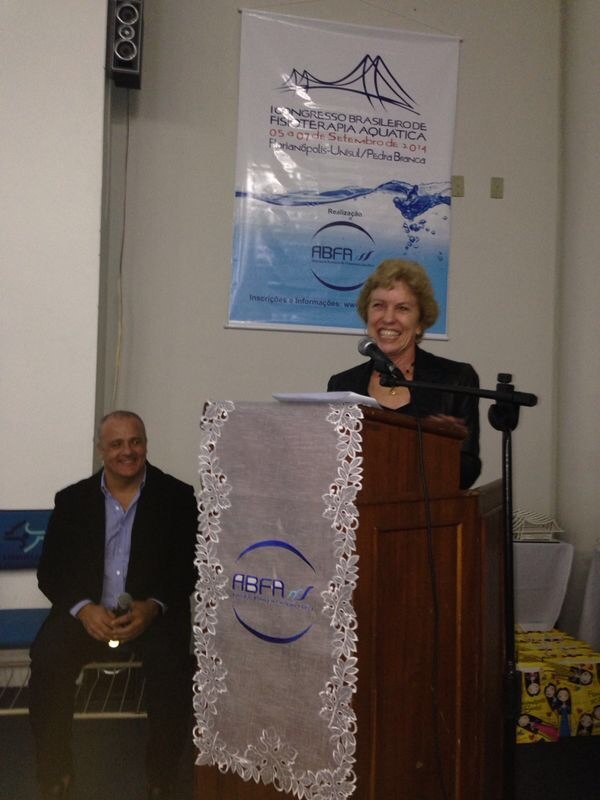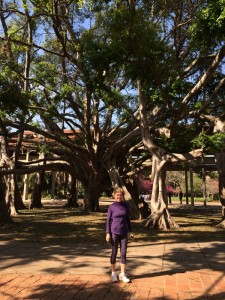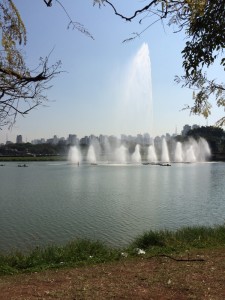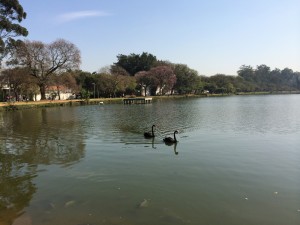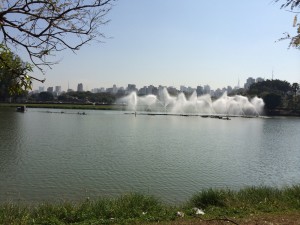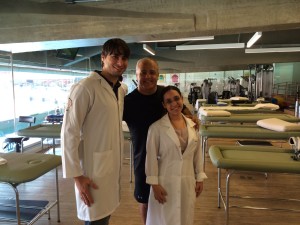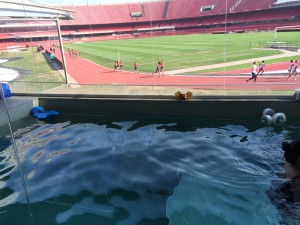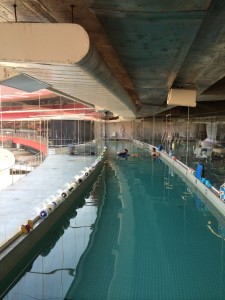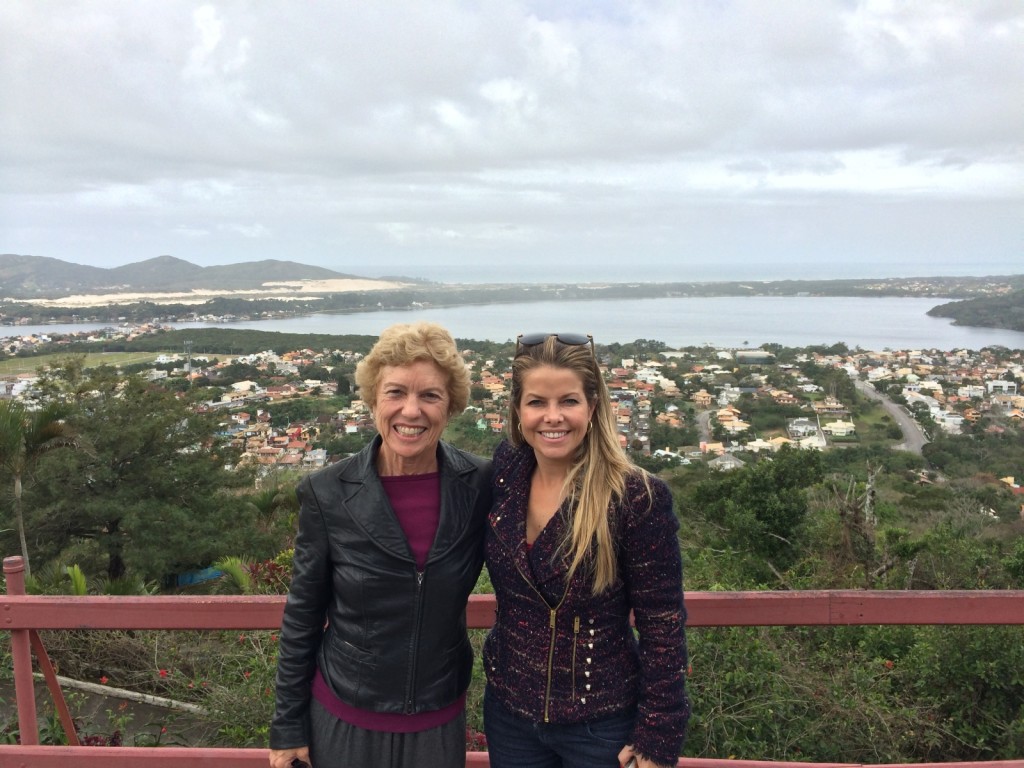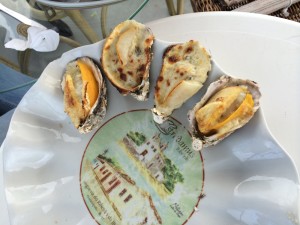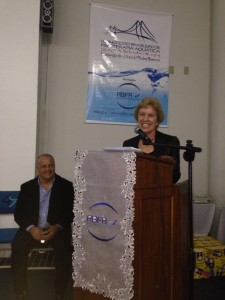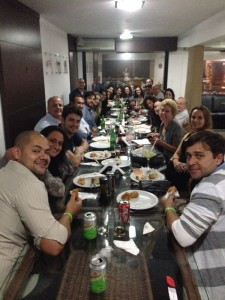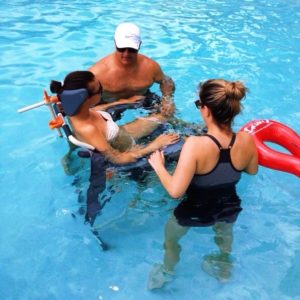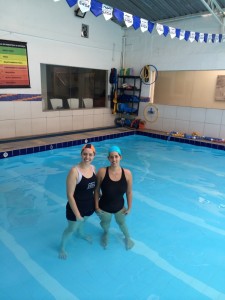The next day was gorgeous, and Douglas took me to Sao Paulo Park, the equivalent of New York’s Central park, albeit a bit smaller with very different vegetation. I was stunned by the immensity of the city. It was as though someone took a dozen Manhattans and jammed them next to one other – it was high rises and high rises as far as we could see and as far as we drove. The park was lovely with black swans in the lake and a mesmerizing fountain that kept changing its configuration of water sprays. I watched and took photos for nearly ten minutes and never saw the same thing twice.
Douglas was an incredibly gracious host throughout my visit. He had told me of his unique pool that curved along the outside of the city’s soccer stadium. But I hadn’t realized what an incredible jewel his Instituto Vita would be until I saw it for myself. What luxury! It reminded me of the old days of physical therapy when we were well paid by insurance companies and we could easily be profitable, which meant we could have lots of “extras.” They handed out plush towels and bathrobes to all those going into the pool. Lucky me, I was one of them. I went into his 93-degree pool for my own workout. The slippery tile on the bottom of the pool surprised me, but I would see throughout my trip that every single pool I visited in Brazil had a slippery tile bottom surface, unlike the plaster bottoms here in the U.S., which provide good traction. Also like the other pools I visited, they had an excess of overly shallow water that wasn’t even up to waist level, which wasted valuable space in the pool and was would go unused except by small children. (For most plyometric exercises, we make sure everyone is working in mid-chest-deep water.) The last 10-15 feet and the end of the pool was deep, which made me happy. I’ve learned that over half of the benefit of pool therapy comes from taking the weight off the knees, hips, back, legs, and feet so they can heal while fitness is gained or maintained.
Douglas took me to lunch at the nearby café, which must be fantastic for all those who work there. Great, fast, buffet with lots of variety. I tried quail eggs for the first time and loved them. Although I can fumble along in French and Italian, I don’t know much Portuguese, and although I tried, not much of it would stick. So Douglas connected me with doctors and therapists who spoke English so that I could chat with them. I learned the history of the clinic. Sixteen of the top orthopedic doctors in Sao Paulo got together and decided to create the best clinic ever. Douglas and one of the surgeons had known each other for years. When the doctor called Douglas and told him the idea, Douglas asked if there was going to be a pool. The doctor said no, to which Douglas replied, “Then it won’t be the best clinic ever!” They quickly altered the plans and squeezed in a pool around the track as seen in the photos. Douglas is in charge of the physical therapy and the doctors and therapists work in the same clinic taking great care of patients who might be trying to prevent orthopedic surgery, be preparing for surgery, or recovering from surgery. They afford the luxuries of this first-class facility by having mostly private paying patients, ones who pay for their care from their own pockets.
Douglas hadn’t intended to work that day, but when his patients started arriving and seeing him there, he began talking with them, and before long he was wearing his white coat and treating his patients. One of his female patients was a champion kick boxer. Douglas, as a gold medalist in judo at the 1987 Pan American Games, could help get her ready for competition. But over the weekend, she had broken her wrist and was there on a table wearing a cast.
The next day, Wednesday, we flew to Florianopolis, an island on Brazil’s East Coast. Physical therapist Romulo Brito met us there and took us to lunch. He and Douglas went over details of the Aquatic Therapy Symposium they had organized that would start on Friday at a local university. It was billed as the First International Aquatic Therapy Symposium. I think I was the international part.
Thursday was a sightseeing day with Lisianne Fabris, one of the many beautiful women of “Floripa” as the locals call it. It was astonishing to see so many stunning beauties everywhere you looked. Lisianne and I had planned to go body boarding that day. I had packed my wetsuit and fins. But rainy, cold weather stopped us. Instead Lisianne showed us her island. There’s a gorgeous fresh-water lagoon and overlook.
We drove to the beach where we would have caught some waves if conditions had been better. Lovely, but nobody out surfing..
We drove around the island and stopped for lunch.
Even though I’d only met Lisianne that morning, I felt like I was on vacation with a long-time friend. She and Douglas and I crossed to the other side of the island where they wanted to show me the oyster farms. Douglas asked if I’d heard of Nostradamas. Of course! Well, he wanted to show me Osterdamas. “If you love oysters, this is the place you have to eat.” They showed me the oyster farms just off shore and said that every morning planes left that area with oysters for all of Brazil. Since he loved oysters, we stopped for him to eat some. Lisianne and I passed on the oysters and had dessert instead.
Friday came and the Symposium opened. All of the work by Lisianne, Romulo, Douglas, and others came to fruition. Dignitaries from the university gathered and gave speeches. Romulo and Lisianne turned the focus toward aquatic therapy, and then I gave the Grand Opening Address to 150 attendees. I used Douglas as my translator, but I could tell a few women in the front rows could speak English, because they would nod and smile as I spoke rather than having to wait to hear the translation.
I gave some background of what we learned from working with many of the world’s best athletes in water in the 1980s and 1990s – brief stories of Florence Griffith Joyner, Wilt Chamberlain, Willie Banks, Mike Powell, and Bo Jackson. Then I addressed the topic of preventing knee and hip surgery. In Brazil, the therapists hadn’t yet heard of the Finnish research study that showed that meniscus surgery may help no more than a fake operation. Physical therapy was the suggested alternative rather than having arthroscopic knee surgery. They had also not heard of the recent American study that concluded that over one-third of all total knee replacements done in America in the last five years were inappropriate based on patient surveys of their pain levels and ability to function. I taught them about deep-water prevention, prehab, or rehab for knees and hips – how we always hope to prevent the surgery, but if the problem doesn’t resolve, our work may turn into prehab for surgery. And in other cases, where patients come to us for the first time after they’ve already had surgery, we do the rehab starting in deep water where there is no weight bearing.
Later that evening, it was time to go to the pool. We used the diving well and the CompletePT flotation belts I brought with me to demonstrate deep-water interval training, deep-water exercises, and kick training.
Then we changed pools to have shallow, warmer water for the running and jumping (plyometric) exercises.
The next day, the seminar speakers would all be talking in Portuguese, so I took the day off and relaxed, walking along the water front, eating spectacular peanut butter ice cream, buying watermelon and papayas to eat throughout the day. The closing dinner was a traveling circus as we walked from one place to another trying to find somewhere that could accommodate 40 people for a last-minute dinner around 10pm. Yes, Brazil is like eating in Italy or Greece – very late at night.
We finished an all-you-can-eat sushi dinner around 1 am.
On Sunday we went to the airport to fly back to Sao Paulo. About six of us were on the same flight, and we waited together by the gate. A TV news program was about 20 yards away above everyone’s heads. I was facing the TV and Douglas had his back to it. Suddenly on the screen I saw a beautiful young woman in a wheelchair with a head rest. She was on the sidelines of a soccer game and a player came running over to her to kiss her. “Douglas!” I interrupted. “Is that the patient you were telling me about?” Douglas had told me the story of Lais Souza who was a two-time Olympic gymnast for Brazil. He had treated her for a torn labrum in her hip as well as after elbow and knee surgeries.
Since she was in her mid-twenties and old for a gymnast, she switched sports and made the 2012 Brazilian Olympic team in Freestyle Skiing (trick jumping, something fairly easy for a skilled gymnast). She had never seen snow until just about 6 months before she was to compete in the Winter Olympics. She was training in Park City, Utah, when she crashed into a tree and sustained severe traumatic injuries that left her unable to use her arms or legs. She was moved from Park City to Miami to obtain the best care for the spinal cord injury. Douglas flew there to help her in the pool.
Douglas ran over to the TV monitor and watched the rest of the broadcast. Yes, it was his patient Lais Souza as seen in the photos above.
Monday was my final day in Brazil before taking a red-eye flight back to L.A. Rosane Caetano spoke excellent English and gave me a tour of SAGA, her aquatic therapy clinic, which has 3 pools. I taught Rosane’s staff the same deep-water intervals, deep-water exercises, and kicking series I had taught in Floripa.
Rosane arranged for me to visit the hospital where she had worked previously, AACD, a hospital for disabled children primarily, but where adults were also being treated with physical therapy, aquatic therapy, occupational therapy, and many other treatments. We were allowed to observe a 13-year-old girl with cerebral palsy as she was taken through a LOKOMAT treatment – an amazing high-tech machine with body harness and a treadmill plus mechanical legs that force the patient’s own legs to move in time to a rhythmic, mechanical cadence while the patient watches a virtual walk through the park for biofeedback.
I got to observe rush hour in Sao Paulo first hand as Douglas drove me to the airport. It was very similar to rush hour in L.A. We got there right on time and I relaxed knowing that since I was on American Airlines, I would be back in the USA the moment I stepped onto the plane.
Lynda Huey, M.S., founder of CompletePT Pool & Land Physical Therapy and Huey’s Athletic Network, was a member of Wilt’s Wonder Women. She has cross trained many of the world’s best athletes in water from track and field, basketball, baseball, tennis, ice hockey and other sports. Lynda, an international speaker, is the author of four books on water exercise and water rehabilitation.
She has licensed her pool protocols to major health care providers, and her training methods will soon be available online at LyndaHuey.com.
To sign up for Lynda’s free monthly newsletter with video of pool exercises you can use right now, go to LyndaHuey.com.

